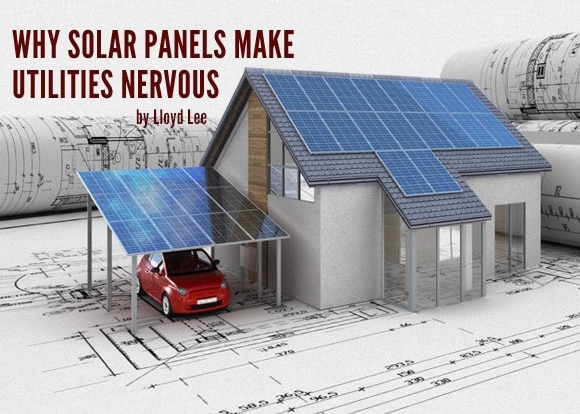Solar energy, indeed almost all renewable energy sources with the exception of hydroelectric, constitute but a mere drop in the bucket when it comes to the share of electrical energy generated in the United States. While renewables contributed over 13 percent of the nations electrical production in 2012, a large majority is generated purely from hydroelectric power plants. Unfortunately, damming up the nation’s waterways, along with the attendant destruction of river ecosystems and regional landscapes, is an unconscionable solution. This leaves solar and wind as the primary hope of the green sector, both of which have grown by leaps and bounds in the past decade. The solar sector has positively exploded since 2000, growing from 4 megawatts of capacity to 3,113 as of 2012. Nonetheless, solar still only contributed a hair over one-tenth of a percent of the nation’s total power output in 2012.
Why then, do top executives of many of the nation’s largest utilities consider solar a threat?
The answer lies in the very nature of solar as an energy source itself.
The Effects of Centralization
Unlike traditional fossil fuels, and to a degree even wind power and hydroelectric generation, solar power is effectively available anywhere the sun shines. Conventional modes of power generation, however, rely on massive centralized plants which must have electricity they produce routed hundreds, even thousands of miles away to where power is actually needed. This is an inherently wasteful model of energy production informed more by the needs of the Industrial Revolution than by our modern age. However, the Industrial Revolution in the United States ended more than a century ago, and in its place the nation has undergone an information and computing revolution. Yet our power production infrastructure hasn’t kept up. Utilities, an invention of the late 1800’s, continue to hold the keys to both production and grid access. As a result, costs have been mostly dictated by investors and owners at the expense of consumers.
If the problem is centralization of the means of production and channels of distribution, the solution is distribution. That’s where solar comes in.
Distributed Solar Solutions
This is not a green sector versus big oil or king coal argument. Even certain renewable applications, such as massive solar and wind farms located on the fringes of society fall prey to the same sin of centralization. Wind in particular, is a renewable energy form that boasts exponential growth, huge energy potential, and near-zero carbon emissions. While much friendlier to the environment than conventional means of production, wind energy must still be distributed via the traditional grid.
Solar, on the other hand, has the greatest potential for democratizing the entire energy landscape from production, to distribution, to consumption. Solar energy has the potential to combine all three of those currently compartmentalized phases into a single efficient entity. For example, homeowners who have installed enough solar capacity could produce their own energy, distributed directly from the sun to the home, and used exactly where its made. The benefits to this model are numerous, and the threat to existing energy establishments are profound.
To this effect, NRG energy, the nation’s largest power provider to utilities, recently announced that it will begin installing solar arrays directly on the rooftops of homes and businesses effectively leapfrogging the 370 billion dollar energy distribution industry. Interestingly, NRG owns a number of utilities operating in Texas, including Reliant Energy which lends its name to the Houston Texans Reliant Stadium. It will be interesting to see howNRG evolves its solar ambitions in a solar-ready climate alongside a more traditional utility model.
As it stands today, grid power, as distributed from centralized coal or gas plants, is the nation’s primary power source. Solar, for the most part, plays a backup role. However, Jim Rogers, chairman and CEO of Duke Energy himself admits:
“If the cost of solar panels keeps coming down, installation costs come down, and if they combine solar with battery technology and a power management system, then we have someone just using us NRG’s long term plan is to eventually render traditional utilities and conventional power plants obsolete. However, to get to that point, two things need to happen – support for renewables must reach a critical mass, and the problem of energy storage, as related to renewable intermittency, must be solved. Despite mild bumps in the road, support for solar power still transcends class, culture, and political divide. In fact, traditionally conservative states in the sunny south, such as Texas and Arizona have the most solar potential, and the most to gain from the adoption of solar power. Many states that have benefited heavily from the fossil fuel industry, such as Texas, could continue to be the energy leaders of the future by transitioning to other abundant alternatives such as wind, solar, geothermal, or even tidal. NRG is betting that as the costs of residential solar arrays become more and more competitive, customers will begin to realize that they don’t need utilities at all. Someday, every home could be its very own power plant, providing cheap, clean electricity directly to where it is needed. Residents will look at the past and wonder how citizens of this carbon-soaked era lived at the mercy of an archaic grid system. The truth is, solar power, unlike any other renewable or conventional energy source currently known to man, has the single greatest potential to democratize the entire energy sector. That can be a rather scary thought for centralized energy generators and the middlemen who distribute that power to customers. Utilities Utilities Utilities Utilities Utilities Utilities Utilities UtilitiesUtilities

































Dear Mr. Llyod,
Nice article. I agree with you, no body wants to give you independent power.